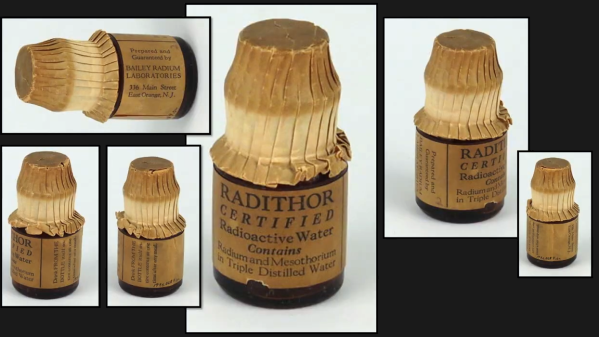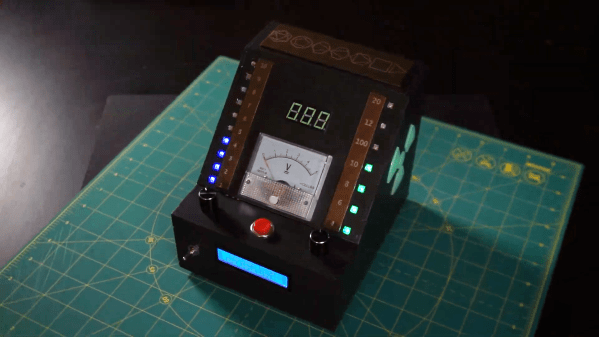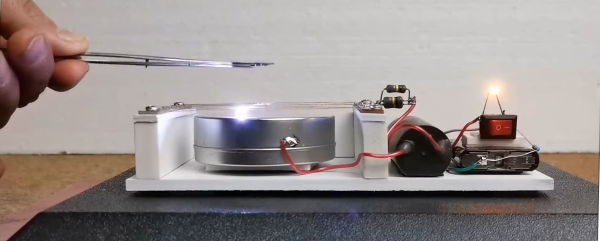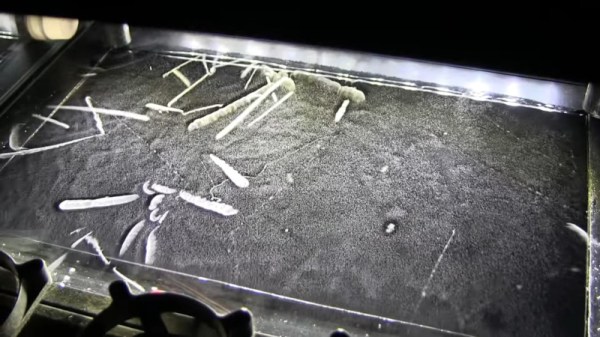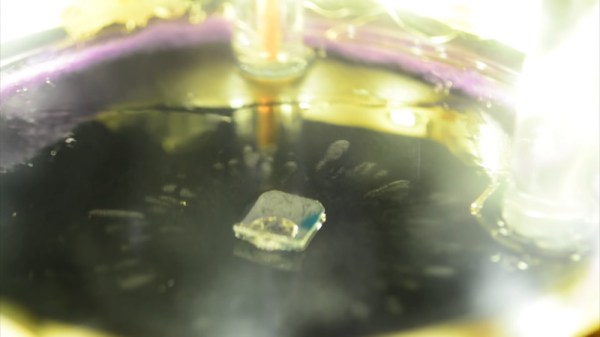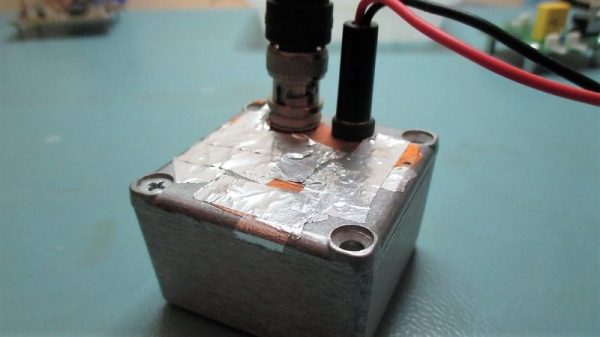Take a little time to watch the history of Radithor, a presentation by [Adam Blumenberg] into a quack medicine that was exactly what it said on the label: distilled water containing around 2 micrograms of radium in each bottle (yes, that’s a lot.) It’s fascinatingly well-researched, and goes into the technology and societal environment surrounding such a product, which helped play a starring role in the eventual Food, Drug, and Cosmetic Act of 1938. You can watch the whole presentation in the video, embedded below the break. Continue reading “Radioactive Water Was Once A (Horrifying) Health Fad”
radioactivity13 Articles
Roll The Radioactive Dice For Truly Random D&D Play
When you have a bunch of people gathered around a table for a “Dungeons & Dragons” session, you have to expect that things are not always going to go smoothly. After all, people who willingly create and immerse themselves in an alternate reality where one bad roll of the dice can lead to the virtual death of a character they’ve spent months or years with can be traumatic. And with that trauma comes the search for the guilty — it’s the dice! It’s always the dice!
Eliminating that excuse, or at least making it statistically implausible, is the idea behind this radioactively random dice roller. It comes to us from [Science Shack] and uses radioactive decay to generate truly random numbers, as opposed to the pseudorandom number generators baked into most microcontrollers. The design is based on [AlphaPhoenix]’s muon-powered RNG, but with a significant twist: rather than depending on background radiation, [Science Shack] brought the power of uranium to the party.
They obtained a sample of autunite, a weird-looking phosphate mineral that contains a decent amount of uranium, perfect for stimulating the Geiger counter built into the dice roller. Autunite also has the advantage of looking very cool under UV light, taking on a ghostly “fuel rod glow,” in the [Homer Simpson] sense. The decay-powered RNG at the heart of this build is used to simulate throws of every standard D&D die, from a D4 to a D100. The laser-cut hardboard case holds all the controls and displays, and also has some strategically placed openings to gaze upon its glowing guts.
We really like the design, but we have to quibble with the handling of the uranium ore; true, the specific activity of autunite is probably pretty low, but it seems like at least some gloves would have been in order.
Continue reading “Roll The Radioactive Dice For Truly Random D&D Play”
Detecting Alpha Particles Using Copper Wire And High Voltage
If you want to measure radioactivity, nothing really beats a Geiger counter: compact, rugged, and reasonably easy to use, they’re by far the most commonly used tool to detect ionizing radiation. However, several other methods have been used in the past, and while they may not be very practical today, recreating them can make for an interesting experiment.
[Mirko Pavleski] used easily obtainable components to build one such device known as an alpha radiation spark detector. Invented in 1945, a spark detector contains a strong electric field into which discharges are triggered by ionizing radiation. Unlike a Geiger-Müller tube, it uses regular air, which makes it sensitive only to alpha radiation; beta and gamma rays don’t cause enough ionization at ambient pressure. Fortunately, alpha radiation is the main type emitted by the americium tablets found in old smoke detectors, so a usable source shouldn’t be too hard to find.
The construction of this device is very simple: a few thin copper wires are suspended above a round metal can, while a cheap high-voltage source provides a strong electric field between them. Sparks fly from the wires to the can when an alpha source is brought nearby; a series resistor limits the current to ensure the wires don’t overheat and melt.
Although not really practical as a measurement device, the spark detector can nevertheless be used to perform simple experiments with radioactivity. As an example, [Mirko] demonstrates in the video embedded below that alpha particles are stopped by a piece of paper and therefore present no immediate danger to humans. The high voltage present in the device does however, so care must be taken with the detector more than with the radiation source.
We’ve seen several homebrew Geiger counters, some built with plenty of duct tape or with the good old 555 timer. But you can also use photodiodes or even certain types of plastic to visualize ionizing radiation.
Continue reading “Detecting Alpha Particles Using Copper Wire And High Voltage”
Building A Bigger Cloud Chamber
Cloud chambers are an exciting and highly visual science experiment. They’re fascinating to watch as you can see the passage of subatomic particles from radioactive decay with your very own eyes. Many elect to build small chambers based on thermoelectric Peltier elements, but [Cloudylabs] decided to do something on a grander scale.
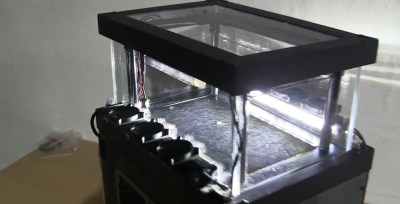
[Cloudylabs] started building cloud chambers after first seeing one in a museum back in 2010. The first prototype was an air-cooled Peltier device, with a cooled area of just 4x4cm. Over the years, and after building many more Peltier-based chambers, it became apparent that the thermoelectric modules were somewhat less than robust, often failing after many thermal cycles. Wanting to take things up a notch, [Cloudylabs] elected to build a much larger unit based on phase-change technology, akin to the way a refrigerator works.
The final product is astounding, consisting of a 32x18cm actively cooled area mounted within a large glass viewing case. A magnet is mounted underneath which causes certain particles to curve in relation to the field, as well as an electrically charged grid up top. The chamber is capable of operating for up to 12 hours without requiring any user intervention.
Cloud chambers are always beautiful, and even moreso at this larger scale. When radioactive materials are introduced into the chamber the trails generated are long and easily visible. It’s a daunting build however, and the final product weighs over 30 kilograms. You might want to start with something a little smaller for your first build. Video after the break.
A Stacked Peltier Cloud Chamber Build
Subatomic particles are remarkably difficult to see, but they can be made visible with the right techniques. Building a cloud chamber with dry ice is a common way to achieve this, but coming by the material can be difficult. [The Thought Emporium] wanted a more accessible build, and went for a Peltier-based design instead (Youtube link, embedded below).
By stacking several Peltier coolers in a cascade, it’s possible to increase the temperature differential generated. In this design, the copper plate of the chamber is cooled down to -33 degrees Fahrenheit (-36.11 Celcius), more than cold enough for the experiment to work. Alcohol is added to the glass chamber, and when it reaches the cold plate, it creates a super-saturated vapor. When disturbed by charged particles zipping out of a radioactive source, the vapor condenses, leaving a visible trail.
Cloud chambers are a popular experiment to try at home. It’s a great science fair project, and one that can be easily constructed with old computer parts and a couple of cheap modules from eBay. Just be careful when experimenting with radioactive sources. Video after the break.
Flip Chips And Sunken Ships: Packaging Trick For Faster, Smaller Semiconductors
You may have heard the phrase “flip-chip” before: it’s a broad term referring to several integrated circuit packaging methods, the common thread being that the semiconductor die is flipped upside down so the active surface is closest to the PCB. As opposed to the more traditional method in which the IC is face-up and connected to the packaging with bond wires, this allows for ultimate packaging efficiency and impressive performance gains. We hear a lot about advances in the integrated circuits themselves, but the packages that carry them and the issues they solve — and sometimes create — get less exposure.

Let’s have a look at why semiconductor manufacturers decided to turn things on their head, and see how radioactive solder and ancient Roman shipwrecks fit in.
Continue reading “Flip Chips And Sunken Ships: Packaging Trick For Faster, Smaller Semiconductors”
Radiation Detector Eschews Tubes, Uses Photodiode
When the topic is radiation detection, thoughts turn naturally to the venerable Geiger-Müller tube. It’s been around for ages, Russian surplus tubes are available for next to nothing, and it’s easy to use. But as a vacuum tube it can be somewhat delicate, and the high voltages needed to run it can be a little on the risky side.
Luckily, there are other ways to see what’s going on in the radioactive world, like this semiconductor radiation detector. [Robert Gawron] built it as a proof-of-concept after having built a few G-M tube detectors before. His solid-state design relies on a reverse-biased photodiode conducting when ionizing radiation hits the P-N junction. The tiny signal is amplified by a pair of low-noise op-amps and output to a BNC connector. The sensor’s analog output is sent to an oscilloscope whose trigger out is connected to a Nucleo board for data acquisition. The Nucleo is in turn connected to a Raspberry Pi for totalizing and logging. It’s a complicated chain, but the sensor appears to work, even detecting alpha emissions from thoriated TIG electrodes, a feat we haven’t been able to replicate with our G-M tube counter.
[Robert]’s solid-state detector might not be optimal, but it has promise. And we have seen PIN diodes used as radiation detectors before, too.
[via Dangerous Prototypes]

